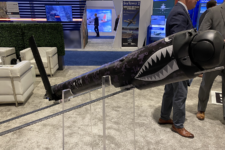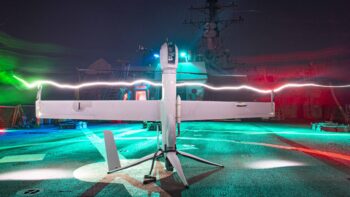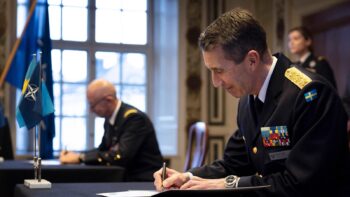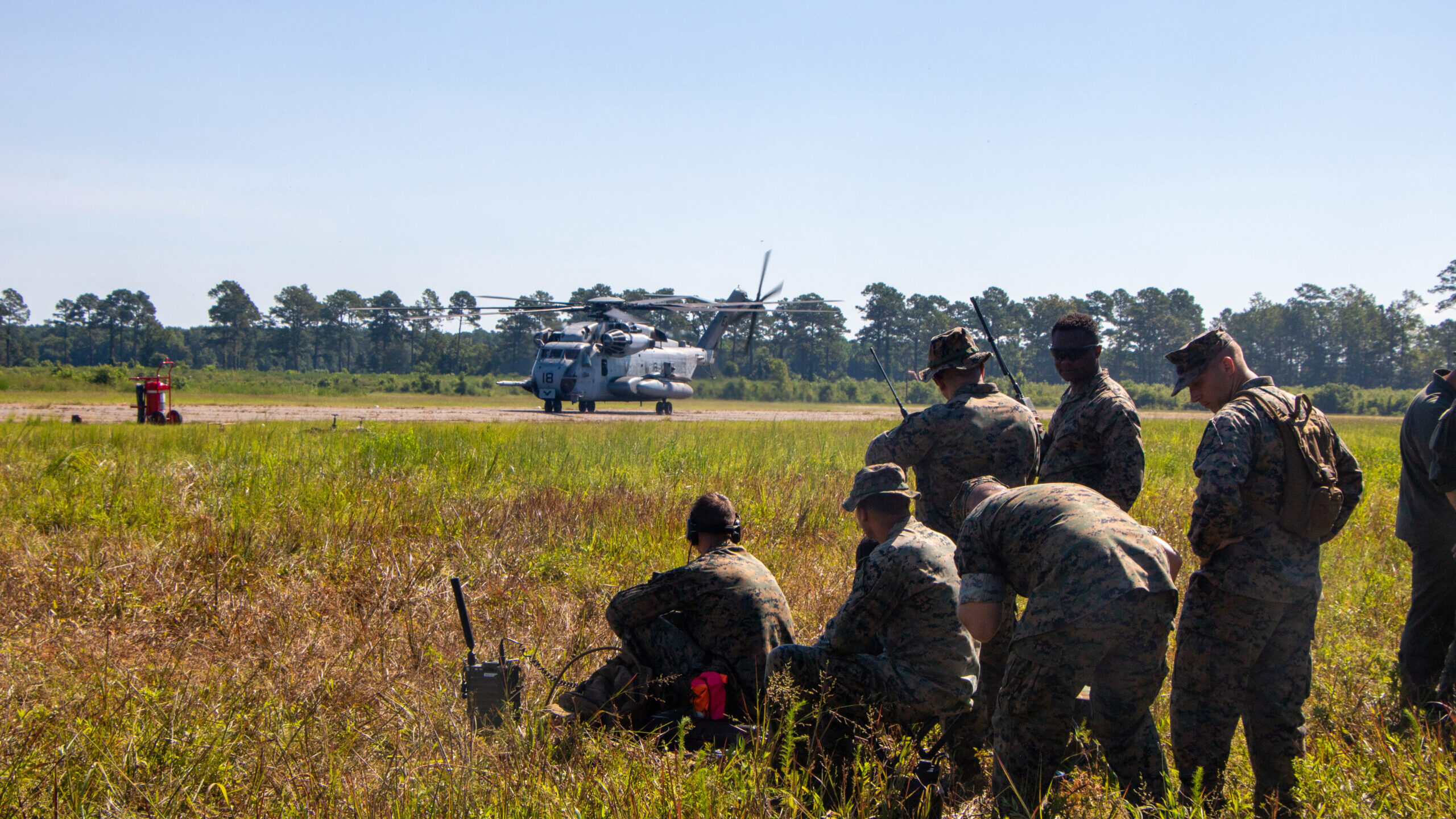
Marines with Combat Logistics Regiment 2 watch as a CH-53E helicopter lands near their expeditionary base located several miles away from Cherry Point, N.C. (Justin Katz/ Breaking Defense.)
Editor’s Note: This is the third in a series of stories about the US Navy and Marine Corps’ Large Scale Exercise 2023. The services provided Breaking Defense and other reporters an up close and personal look into how they are executing their biggest — and exclusively naval — training exercise.
MARINE CORPS BASE IN OAK GROVE, N.C. — A group of six Marines intently watched a CH-53E helicopter slowly approach the refueling station set up several hundreds yards down the landing strip here in rural North Carolina.
The Marines had established a “forward arming and refueling point,” or a FARP, and in most situations, the refueling itself would be a standard event for Combat Logistics Regiment 2. But this particular training event is part of Large Scale Exercise 2023 involving Marine and Navy assets around the world, which means complications — some intentional and some not — can happen at any time.
“The more spread out you are, the less control you can have,” 1st Lt. Anthony Viteri, a combat engineer officer with Marine Wing Support Squadron-271, told reporters. “So, you have to put a lot more trust in the people who are on deck.”
For the Marines here, the globe-spanning exercise was a stress test both of how well the Marine Corps could operate in sync with sailors underway, while also implementing their own new warfighting doctrine that calls for them to operate in smaller units while within the range of enemy fires.
Combat Logistics Regiment 2 commander Col. Ginger Beals said she emphasized “the naval integration” with her Marines, “The relationship between the Marine Corps and the Navy and … how we communicate with one another.”
While communication between Marines and sailors underway might sound natural in theory, the reality is the Corps has spent the past two decades in the Middle East fighting a ground war. Getting back to the Marines’ “naval roots” has been an emphasis for the service’s leadership in recent years as the Pentagon reorients its focus toward the Indo-Pacific.
Operating spread out and in dispersed environments is one of the intentional complications in Large Scale Exercise 2023. The goal is to test everyone from commanders down to the individual Marine at the tactical level who, under the Corps’ latest warfighting concepts, is now responsible for operating with much lower signatures.
The capability for Marines to fight in a far more dispersed and lower-profile way than in the past is reflected in two key modern Marine warfighting concepts: Stand-In Forces and Expeditionary Advanced Base Operations (EABO). Put these two documents together and it describes a Marine Corps that aims to operate within the range of enemy fires from austere locations using tactical units that must be as self-sufficient as possible.
Marines all over the world participated in LSE 2023, but the 100 or so here were mostly from Beals’ regiment and were working with the 2nd Marine Air Wing as well as the amphibious transport dock New York and Carrier Strike Group 4.
The regiment’s job was to refuel — and if there had been combat operations ongoing, re-arm — aircraft operating with the carrier strike group off the coast, all while keeping their presence discrete and location secure. In the two-week time span of LSE, Aug. 9 to Aug. 18, roughly 30 CH-53Es, CH-53Ks and MV-22Bs were expected to come through the refueling site, the Marines said.
“We’re normally used to operating off of a more established area,” Viteri said. “Here, we are trying to have a low signature and just keeping accountability between the different sites, keeping communication between each other.”
Prior to the exercise, the service conducted electromagnetic spectrum analysis of the area and repeated that process once the forward base was up and running. Comparing the results of those two analyses will inform service planners of how to tweak operations to improve the odds in a real conflict that the CLR would not be easily detected.
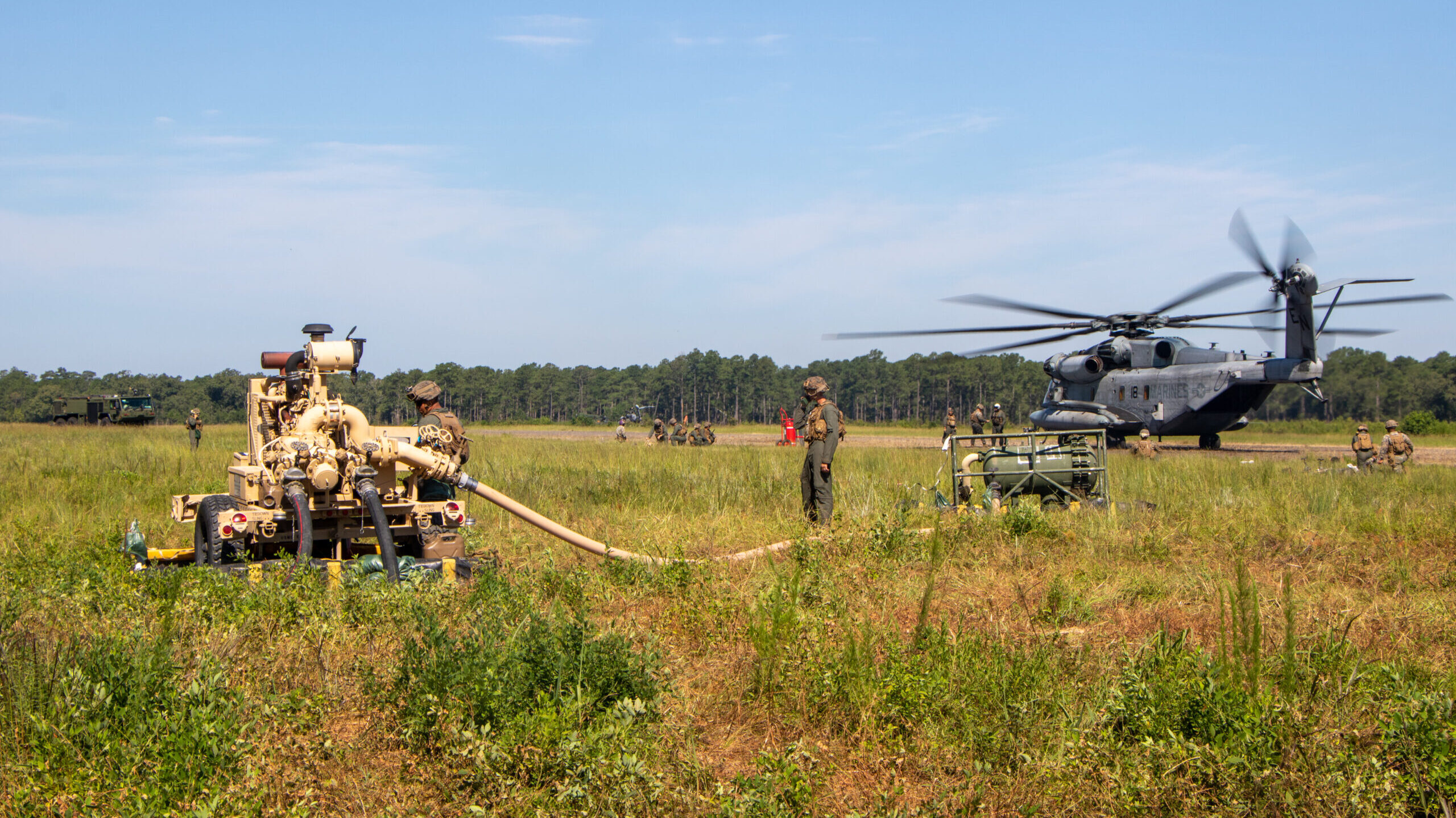
Marines with Combat Logistics Regiment 2 refuel a CH-53E helicopter during an evolution at a “forward arming and refueling point.” (Justin Katz/ Breaking Defense.)
Surprises, Both Planned And Unplanned
The exercise would involve some curveballs thrown by the organizers, but others presented themselves as naturally as they would in a real conflict.
Down the field, Sgt. Nicolas Casson, the FARP point officer in charge, said some issues, such as leaks in fuel tanks, were discovered in the moment and were the result of certain pieces of equipment simply being used infrequently.
In this scenario, Casson and his Marines understood how to identify those problems and resolve them. But unexpected hiccups like that point to another broader issue that operating in smaller units inevitably surfaces: the need to cross-train. Put another way, specific squadrons being present to help work through issues — such as a fuel tank leaking — may not always be available in a real operation.
Capt. Jason Motycka, a CH-53E pilot with HMH-464, was the senior officer for his detachment at this base just a 10- to 15-minute helicopter ride away from the Marines’ permanent installation at Cherry Point. He said he is accustomed to working with his wing support squadron when he flies, but for the purposes of Large Scale Exercise, an engineering support battalion was on hand at the forward base.
“Operating with logisticians outside the wing — that’s just great cross training, especially in the EABO construct be able to be survivable and operate further out with different units, that just gives us flexibility to continue to operate in this distributed environment,” he said.
And after the Marines leave this base the cycle of re-writing and re-planning for future operations will continue based on what happened here. In fact, the particular requirements for fuel, maintenance, personnel and other necessities for pilots was already in its fourth or fifth iteration, Motycka said.
“We might not have the right answer yet, but we can get there and continue to codify those things and look for those solutions as we go forward,” he said.










